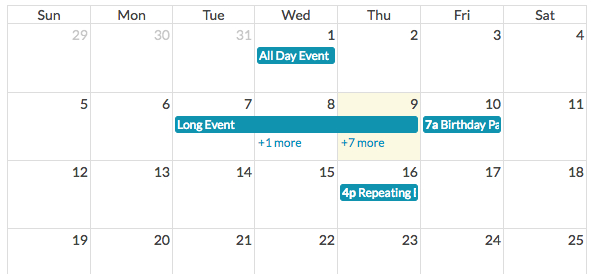数据库 性能优化案例分析之二:时间区域查询的性能优化
背景
我们在项目中经常会遇到把事件显示在日历上的需求,在项目管理,事件追踪,预约等相关功能中很常见,界面通常类似这样:

常见的做法是给对应表添加开始时间和结束时间的栏位:start_time and end_time,然后构建一个查询得到这个时间段内的数据,示意如下:
|---给定时间段---|
|---A---| |---B---| |-C-| |---D---|
查询要排除掉 A 和 D 这种数据,也就是结束时间小于给定的开始时间,或者开始时间大于给定的结束时间:not (end_time <= :start or start_time >= :end)
从 NOT (A OR B) 可以得到 (NOT A) AND (NOT B),最终的查询语句是这样:
select * from events where end_time > :start and start_time < :end
考虑到这是一个范围查找,通常都会给这 2 个栏位加上索引,数据量小的时候,这个查询效率很高,但在数据增加到百万级别之后,在慢查询日志里面经常会发现这个查询耗时超过几百毫秒,随着数据量的增加,甚至超过 3000 毫秒。
分析过程
继续用慢查询的分析过程套路
第一步:EXPLAIN
有时候相同的查询语句,只是查询参数少许不同,会导致预估的 IO Cost 不同,执行计划也会改变,我们可以看到,这个查询有时候会用 start_time 的索引,有时候会用 end_time 的索引:
explain select * from events where end_time > '2017-05-01 00:00:00' and start_time < '2017-06-01 00:00:00'\G
select_type: SIMPLE
table: events
partitions: NULL
type: range
possible_keys: index_events_on_start_time,index_events_on_end_time
key: index_events_on_start_time
key_len: 5
ref: NULL
rows: 799704
filtered: 50.00
Extra: Using index condition; Using where; Using MRR
explain select * from events where end_time > '2017-08-01 14:00:00' and start_time < '2017-09-01 00:00:00'\G
select_type: SIMPLE
table: events
partitions: NULL
type: range
possible_keys: index_events_on_start_time,index_events_on_end_time
key: index_events_on_end_time
key_len: 5
ref: NULL
rows: 946430
filtered: 50.00
Extra: Using index condition; Using where; Using MRR
第二步:理解执行计划
从执行计划其实已经可以看到这个慢查询的原因:需要检查的行数太多了,预估在 79 万和 94 万。但保险起见,还是从INFORMATION_SCHEMA.OPTIMIZER_TRACE表中获取信息来确认我们的猜测:
{
"index": "index_events_on_start_time",
"ranges": [
"start_time < 0x999d02f000"
],
"rows": 3147211,
"cost": 2.73e6,
"chosen": false
},
{
"index": "index_events_on_end_time",
"ranges": [
"0x999d02e000 < end_time"
],
"rows": 946430,
"cost": 826083,
"chosen": true
}
这个查询相当于构建了 无穷小 <= start_time <= ? 和 ? <= end_time <= 无穷大 这样 2 个开放区间查询。在这里由于前者的开放区间内有超过 300 万的数据需要检查,所以执行计划选择了后者相对比较小的 94 万作为索引。
第三步:分析数据
这个表有超过 600 万的数据:
show table status like 'events'\G
Name: events
Engine: InnoDB
Rows: 6294423
所有的数据开始时间和结束时间均匀分布,索引也没有问题,而且查询除了按月,也有按其他维度(天,日,小时,指定范围)来进行查询,通过添加辅助字段也无法减少开放区间的查询数据量,好像进入了一个死胡同...
解决方案
遇到现有知识无法解决的问题,那就 Google 吧,经过尝试不同的关键字(关于如何选择关键字解决日常搬砖遇到的问题,可以留个坑,以后再写)发现了一篇很详细的文章,和我们遇到的情况是一模一样: https://explainextended.com/2009/07/01/overlapping-ranges-mysql/
文章提到了将时间区间变成二维线段,然后利用 R-Tree (spatial) 索引,通过范围重叠来解决这个性能问题。看起来很不错,那就开动吧。
添加一个辅助字段并添加索引:
alter table events add column time_range linestring;
create spatial index index_events_on_time_range on events(time_range);
然后把时间区间转换成线段更新到这个字段:
update events set time_range = LineString(Point(-1, UNIX_TIMESTAMP(start_time)), Point(1,UNIX_TIMESTAMP(end_time)));
用 MBRIntersects 函数来查询重叠:
select * from events where MBRIntersects(time_range, LineString(Point(0, UNIX_TIMESTAMP('2017-08-01 00:00:00')), Point(0, UNIX_TIMESTAMP('2017-09-01 00:00:00'))));
80 毫秒!相同的查询之前需要 2410 毫秒:
select * from events where end_time >= '2017-07-01 00:00:00' and start_time <= '2017-08-01 00:00:00';
给数据库再加个 trigger,当更新和插入数据时,自动更新 time_range 这个字段:
CREATE TRIGGER events_insert_time_range BEFORE INSERT ON events
FOR EACH ROW
BEGIN
SET NEW.time_range = LineString(Point(-1, UNIX_TIMESTAMP(NEW.start_time)), Point(1, UNIX_TIMESTAMP(NEW.end_time)));
END
CREATE TRIGGER events_update_time_range BEFORE UPDATE ON events
FOR EACH ROW
BEGIN
IF ((NEW.start_time != OLD.start_time) OR (NEW.end_time != OLD.end_time)) THEN
SET NEW.date_range = LineString(Point(-1, UNIX_TIMESTAMP(NEW.start_time)), Point(1, UNIX_TIMESTAMP(NEW.end_time)));
END IF;
END
问题解决收工!
扩展
这个问题有很多可以扩展的问题:
我们之前只会将 R-Tree 用在地理位置的查询,从这个问题可以扩展到时间,IP 地址等其他类似的查询,除了这些范围查询还有其他适合应用的场景吗?
文章中构建的线段是 (-1,start_time) 到 (1,end_time) 的一条斜线,用位于 X 等于 0 的线段去查询重叠。为什么不能用更直观的方式(类似文章开头的线段示意图),构建一个 (start_time, 0) 到 (end_time,0) 一条线段,然后用 Y 等于 0 的线段去查询重叠呢?
如果不用数据库 trigger,在 rails 里面有什么方法能够自动更新这个辅助字段呢?甚至更进一步,是否可以删除掉 start_time 和 end_time 这 2 个字段,只用 time_range 这一个字段来满足所有的查询需求呢?
下篇占坑 性能优化案例分析之三:N:M 的用户动态优化